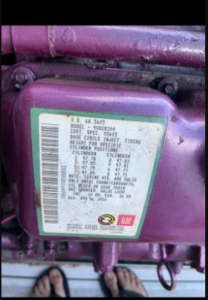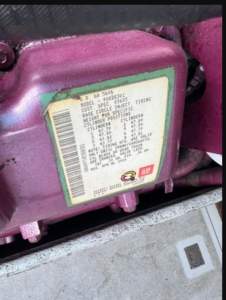Engine Specifications and Design Principles

The Detroit Diesel 8.2L engine, often called the “Fuel Pincher,” is a four-stroke, V-8 diesel engine designed for durability and efficiency. It was engineered to deliver robust performance across various industrial, marine, and transportation applications. Here are the key specifications and principles underpinning its design:
Parts Catalog for 8.2L Detroit Diesel Marine Engine
- Type: Four-stroke cycle diesel engine.
- Configuration: 90-degree V-8 with a cast-iron block.
- Bore and Stroke: 4.25 inches x 4.41 inches (108 mm x 112 mm).
- Displacement: 500 cubic inches (8.2 liters).
- Compression Ratio: Naturally aspirated engines – 18.3:1; Turbocharged engines – 17:1.
- Main Bearings: 5 precision bearings for optimal crankshaft support.
- Firing Order: 1-8-4-3-6-5-7-2.
- Cooling System: Closed system with a centrifugal water pump and thermostatically controlled coolant flow.
- Lubrication System: Full-pressure lubrication with a rotor-type oil pump and dual full-flow filters.
The design emphasizes long life and reliability through:
- Advanced Cooling: Efficient coolant circulation prevents overheating.
- Pressure Lubrication: Ensures critical engine components receive adequate oil under all operating conditions.
- Fuel Injection Precision: Injectors calibrated to optimize fuel combustion and minimize emissions.
- Balanced Performance: Combines high torque and fuel efficiency, making it suitable for both heavy-duty and medium-duty applications.
Safety Precautions During Service

Safety is paramount when working on the Detroit Diesel 8.2L engine. Improper service procedures can lead to severe injuries or damage to the engine. Adhering to the following safety measures ensures both mechanic and engine safety:
- Battery Disconnection: Always disconnect the battery before starting any service work to prevent accidental engine starts.
- Engine Stoppage: Ensure the governor is in the “no-fuel” position to minimize the risk of accidental ignition.
- Lifting Precautions: Use appropriate lifting equipment rated for the engine’s weight, and ensure lifting hooks are securely attached.
- Personal Protective Equipment (PPE): Always wear safety glasses, gloves, and steel-toe boots.
- Ventilation: Work in a well-ventilated area to avoid exposure to exhaust fumes and volatile cleaning agents.
- Compressed Air Use: Follow recommended air pressure limits when using compressed air to clean parts.
- Chemical Handling: Avoid hazardous chemicals like carbon tetrachloride. Use safer alternatives like perchlorethylene in well-ventilated spaces.
- Burn Risks: Allow the engine to cool before performing maintenance to avoid burns from hot components.
- Torque Specifications: Always use a calibrated torque wrench and adhere to specified torque values for fasteners to ensure safe assembly.
Metric vs. Customary Fasteners and Their Importance
The Detroit Diesel 8.2L engine incorporates both metric and customary (imperial) fasteners, reflecting its design heritage and versatility. Understanding and correctly identifying these fasteners is crucial for safe and effective maintenance.
- Metric Fasteners: Identified by size and strength ratings stamped on the bolt head (e.g., M10 x 1.5). These bolts often feature numeric strength indicators such as “8.8” or “10.9.”
- Customary Fasteners: Marked with radial lines that indicate their grade (e.g., three lines for Grade 5, six lines for Grade 8). Threads are specified in inches and thread-per-inch counts (e.g., 3/8″-16 UNC).
Importance of Correct Fastener Selection:
- Strength Matching: Using a fastener with insufficient strength can lead to failure under load, causing engine damage or personal injury.
- Thread Compatibility: Mismatched threads between metric and customary systems can damage components and compromise assembly integrity.
- Reuse Considerations: Always inspect reused fasteners for wear or damage. Replace fasteners showing signs of deformation or corrosion.
- Torque Application: Each fastener type has specific torque requirements. Using the correct torque specification ensures secure assembly and prevents over-tightening or stripping.
Engine Model, Serial Number, and Labeling Guidance

The Detroit Diesel 8.2L engine is identified through its model and serial numbers, which are crucial for ordering replacement parts and ensuring compatibility with specific applications.
-
Location of Serial and Model Numbers:
- Stamped on a metal plate attached to the front upper part of the engine block.
- Additional option labels may be found on the valve rocker cover.
-
Key Information Found on the Labels:
- Serial Number: A unique identifier for the engine, critical for service history and parts orders.
- Model Number: Indicates the engine’s specific configuration and intended application.
- Option Plate Data: Lists additional features or modifications present in the engine, such as turbochargers or emission controls.
Tips for Accurate Label Usage:
- Record the engine’s serial and model numbers before starting any major repair or maintenance project.
- Retain the original labels and option plates whenever possible, as they provide vital information about the engine’s build and configuration.
- When ordering replacement parts, include the serial and model numbers to avoid compatibility issues.
Understanding these foundational aspects of the Detroit Diesel 8.2L engine sets the stage for successful maintenance and troubleshooting, ensuring longevity and peak performance.
Parts Catalog for 8.2L Detroit Diesel Marine Engine



 Free US Calls: 1-888-433-4735
Free US Calls: 1-888-433-4735 International: 305-545-5588
International: 305-545-5588